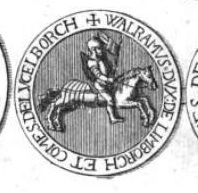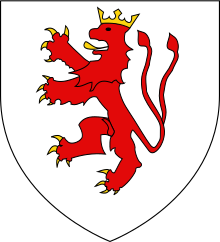| Revision as of 12:11, 8 September 2015 editGcSwRhIc (talk | contribs)Autopatrolled, Extended confirmed users19,831 edits fix link Montjoie is French for Monschau, avoid redirect to Montjoie Saint Denis! article← Previous edit | Revision as of 19:37, 2 March 2016 edit undoKasparBot (talk | contribs)1,549,811 edits migrating Persondata to Wikidata, please help, see challenges for this articleNext edit → | ||
| Line 49: | Line 49: | ||
| {{Authority control}} | {{Authority control}} | ||
| {{Persondata | |||
| | name = Waleran III of Limburg | |||
| | alternative names = Walram IV., Herzog von Limburg (German) | |||
| | short description = Duke of Limburg and Count of Arlon (1221-1226) | |||
| | date of birth =circa 1165 | |||
| | place of birth = | |||
| | date of death = 2 July 1226 | |||
| | place of death = ] | |||
| }} | |||
| {{DEFAULTSORT:Waleran 03 of Limburg}} | {{DEFAULTSORT:Waleran 03 of Limburg}} | ||
| ] | ] | ||
Revision as of 19:37, 2 March 2016
| Waleran III, Duke of Limburg | |
|---|---|
 Seal of Waleran. Seal of Waleran. | |
| Born | c. 1165 |
| Died | (1226-07-02)2 July 1226 Rolduc |
| Buried | Rolduc Abbey |
| Noble family | House of Ardennes-Verdun |
| Spouse(s) | Cunigunda of Lorraine Ermesinda of Luxembourg |
| Father | Henry III of Limburg |
| Mother | Sophie of Saarbrücken |

Waleran III (or Walram III) (c. 1165 – 2 July 1226) was initially lord of Montjoie, then count of Luxembourg from 1214. He became count of Arlon and duke of Limburg on his father's death in 1221. He was the son of Henry III of Limburg and Sophia of Saarbrücken.
As a younger son, he did not expect to inherit. He carried on an adventurous youth and took part in the Third Crusade in 1192. In 1208, the imperial candidate Philip of Swabia died and Waleran, his erstwhile supporter, turned to his opponent, Otto of Brunswick. In 1212, he accompanied his first cousin Henry I, Duke of Brabant, to Liège, then in a war with Guelders. Waleran's first wife, Cunigunda, a daughter of Frederick I, Duke of Lorraine, died in 1214 and in May he married Ermesinda of Luxembourg, and became count Error: {{Lang}}: text has italic markup (help) there. Ermesinda claimed Namur and so Waleran added a crown to his coat of arms to symbolise this claim.
In 1221, he inherited Limburg and added a second tail to the rampant lion on his arms. This symbolised his holding of two great fiefs. In 1223, he again tried to take Namur from the Margrave Philip II. He failed and signed a peace treaty on 13 February in Dinant. He then took part in various imperial diets and accompanied the Emperor Frederick II into Italy. Returning from there, he died in Rolduc.
Family and children
Waleran had four children by his first wife, Cunigunda of Lorraine, daughter of Frederick I, Duke of Lorraine, and three children by his second wife, Ermesinda of Luxembourg:
- Sophie (c. 1190 – 1226/27), married c. 1210 Frederick of Isenberg
- Matilda (c. 1192 – aft. 1234), married c. 1210 William III of Jülich, mother of William IV, Count of Jülich
- Henry IV, Duke of Limburg
- Waleran (c. 1200 – 1242), married Elisabeth of Bar, daughter of Ermesinda of Luxembourg by her first husband, Theobald I, Count of Bar
- Catherine (c. 1215 – 1255), married Matthias II, Duke of Lorraine, nephew of Waleran's first wife
- Henry V, Count of Luxembourg
- Gerhard, Count of Durbuy
External links
| Waleran III, Duke of Limburg House of Ardennes-VerdunBorn: c. 1165 Died: 2 July 1226 | ||
| Preceded byHenry III | Duke of Limburg 1221–1226 |
Succeeded byHenry IV |
| Count of Arlon 1221–1226 |
Succeeded byHenry V | |
| Monarchs of Luxembourg | ||||||||||||||||||||
|---|---|---|---|---|---|---|---|---|---|---|---|---|---|---|---|---|---|---|---|---|
| ||||||||||||||||||||
| ||||||||||||||||||||
| ||||||||||||||||||||
Categories:


